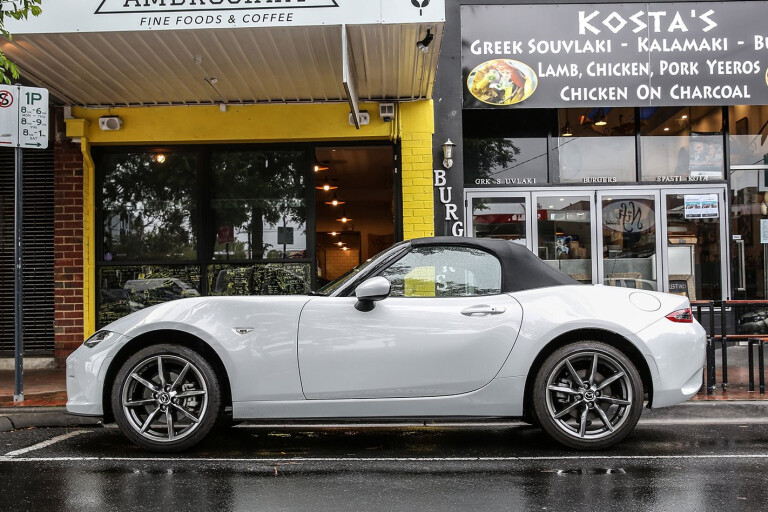
- Introduction: Grunt with grace
- Update 1: Spruced up
- Update 2: Spin classes
- Update 3: Hard Choices
- Update 4: Family Ties
- Update 5: Conclusion
Introduction: Grunt with grace
WITH summer slowly turning up the dial on Melbourne’s temperature, we’re glad to welcome the Mazda MX-5 2.0 Roadster GT. But it has some mighty big tracks to fill.
See, two months ago we bid Chrysler’s mighty 300 SRT goodbye. And in place of a huge 6.4-litre HEMI V8, our new arrival’s plucked its 2.0-litre four banger straight from a Mazda 3, which spins four less cylinders and ignites less than a third of the V8’s capacity. And this is Mazda’s ‘big-block’ variant. Gulp.
That’s right, Japan never really wanted to build this car. If it wasn’t for America stomping its feet about the 1.5-litre base roadster being a little short on poke, it would have never existed.
Yet we’re glad it does, because Mazda hasn’t done this often. Mazda Australia spiced up the second-gen MX-5 with a turbo with the locally-built SP of 2002, which Mazda HQ took inspiration from when creating the more common but less powerful SE of 2004.
Mazda has promised grunt-lovers a longer innings this time ’round, as the MX-5 launched with both the 1.5-litre and 2.0-litre donks to serve up an interesting choice between ‘purity’ and ‘power’.
 Why’d we go for the latter? We threw both into the ring last year and the family fight revealed 500cc makes a lot of difference.
Why’d we go for the latter? We threw both into the ring last year and the family fight revealed 500cc makes a lot of difference.
Compared to the 1.5-litre engine’s 96kW and 150Nm, the larger donk unlocks another 22kW and 50Nm. Packing 118kW/200Nm in total, we’ve seen it cut 0-100km/h in 6.54sec and the 400m in 14.68.
That’s knocking on the door of VW Golf GTI pace, covers off the mini turbo hot hatches you’d find at Ford, Peugeot, or Renault, and is more than a second healthier than its less endowed bro.
Straight-line go isn’t all you get with the bigger engine, either. Mazda also chucks in bigger wheels, beefier brakes, stickier tyres and stiffer suspension. This, it says, help deal with the engine’s extra weight.
But while 24kg counts for more in a car that weighs just over a tonne, 1033kg to be precise, it’s hardly noticed. Our MX-5’s proved lithe as a feather zipping around town and the bowser seems to agree.
Crucially, however, we’ve found the suspension bits to do more than just keep belly fat in check. The engine lets you thrust into traffic gaps more quickly, the ABS remains unfettered and violent pitch and roll has been reduced.
 So, really, Mazda’s saved you the cut knuckles and forum-digging usually needed for an engine swap. And you haven’t had to sit down with a mechanical engineer to dream up the right spring rates, tyre sizes and brake package to suit.
So, really, Mazda’s saved you the cut knuckles and forum-digging usually needed for an engine swap. And you haven’t had to sit down with a mechanical engineer to dream up the right spring rates, tyre sizes and brake package to suit.
Okay, the little 1.5-litre engine’s a zingy delight to rev out, making its slick shift all the more satisfying, and it’s keener to wag its tail. But for hard-driving MOTOR-heads, the 2.0-litre washes up as the smarter choice. Better yet, at $34,490 for the base version, the 2.0-litre’s only $2500 more. And MZD connect (Mazda’s inferior imitation of BMW’s iDrive) is also thrown in to boot.
Don’t get us wrong, it’s not tuner-proof. We’d love to shrink the gap between its wheels and guards, and a couple of Jet Black MX-5s getting around Melbourne make our 2.0-litre’s Crystal White Mica paint look a little bland.
That’s fine, though, because we’ll fix that up over the next few months. The Kuroi styling pack, which proved popular on the Mazda 3, has spurned a new version for the MX-5, and we’ve put our name down for it.
We’ve also pencilled in a date with another standout from Japan. Toyota’s 86 has just been upgraded for 2017, and it’s not just a facelift. So we’ll compare our 2.0-litre to the stiffer, quicker coupe.
First impressions, otherwise, is that inside the MX-5’s certainly no Chrysler 300. We’ve bagged a GT-spec 2.0-litre, that runs up its ask to $39,550 and scores heated seats, leather, along with climate control, but you can sense the compromise around the cabin.
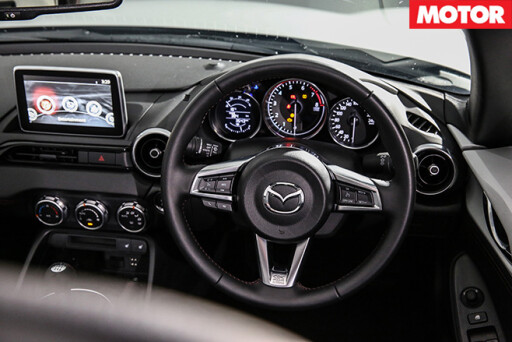 Engineers slaved to make the fourth-generation lighter than the porky NC before it, but you’d appreciate somewhere to hide your phone, more sound deadening at the rear, and a glovebox up front.
Engineers slaved to make the fourth-generation lighter than the porky NC before it, but you’d appreciate somewhere to hide your phone, more sound deadening at the rear, and a glovebox up front.
On the other hand, we love that you can slam-dunk the manually-operated roof whenever you want, and while it’s no 300 SRT to drive, that’s entirely the point. We’ve swapped a Big Mac for sashimi. And we’re relishing the taste.
MONTH ONE
Fuel consumption: 10.95L/100km
Average fuel consumption: 10.95L/100km
Mileage this month: 995km
Total mileage: 3888km
Liked: Top-down on the rare hot day
Disliked: Storing messenger bags in the boot
Favourite moment: Slicing up SUVs in traffic
Update 1: Spruced up
Our Mazda checks in for a new bodykit
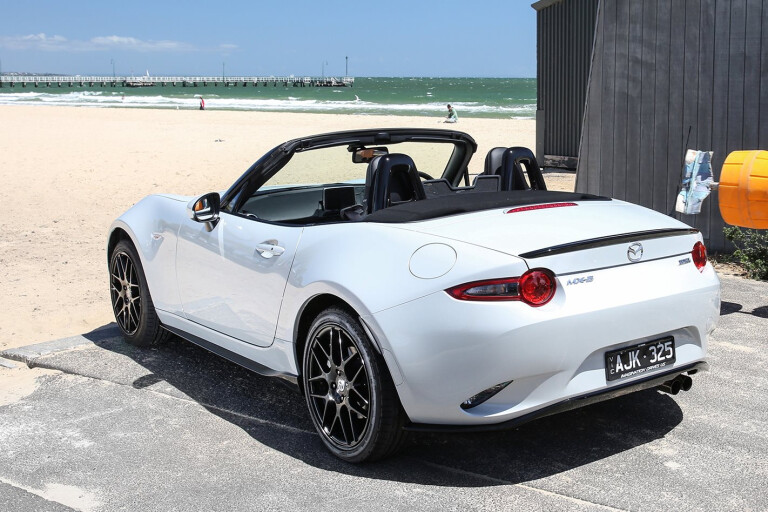
Forgive me, but what I’m about to say is a little superficial. It’s not easy to be seen in an MX-5.
Sure, the ND-series is the toughest looking generation so far with its sculpted front haunches, swoopy silhouette, and squinty eyes. But my last long-termer, a Chrysler 300 SRT, could awe a mobster.
So I’ve felt a little uneasy to fold away our car’s soft-top. Hairdresser taunts start swirling in my mind. And ceramic white isn’t the most brooding shade of colour.

Of course if your MX-5 ambitions suffer the same anxiety there are ways to avoid this. Firstly, you could buy an MX-5 from Fiat. Its new Abarth 124 Spider hunkers lower over 17-inch wheels, offers four-pipes at its rear, and hide red Brembos behind its front wheels.
You could also venture down the aftermarket path. There is already a plethora of parts available for the MX-5. Though we’re not sure how easy coilovers and a wide-body kit would be to live with, and how well they’d get along with warranty.
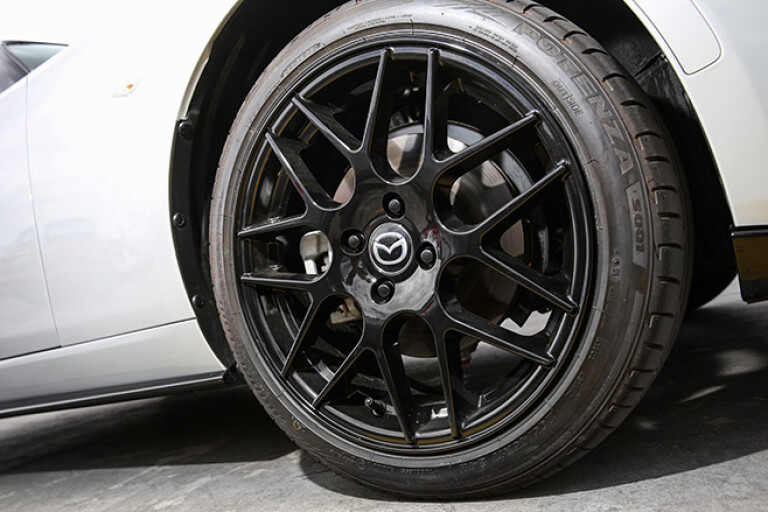
Or you can turn to Mazda, like we did, and tick the box for a ‘Kuroi’ pack. Offered across its model range it sprinkles on a slew of exterior parts. In the MX-5’s case, it pastes on a front and rear lip along with 17-inch Y-spoke alloys and a rear spoiler. All finished in black, warranty intact.
Without the risk of making our MX-5 look any blander, we signed up straight away.
How many days were we without a ride? Hardly any. Our local Mazda dealer simply wheeled the car down the road to a Mulgrave panel shop. Here the bits are bolted on in one day, and then the car was ready for pick-up the following afternoon.
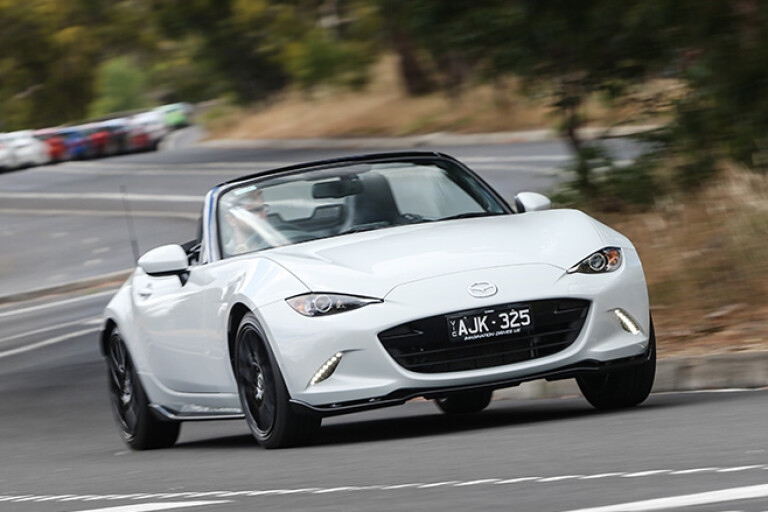
We know what you’re thinking. If it’s so easy, you could just order the parts yourself and have a crack in your garage. Well, there isn’t much point if you crunch the numbers.
After scrounging around online I found the bits for $3650, a fair bit cheaper than Mazda’s price of $4031 fitted, which amounts to a decent saving. But the boys at Police Road Panel Service revealed you’ll at least need a nut insert tool to actually fit the pack, which can run up to $200. And after dropping by to see them at work, I figured a couple hundred bucks is what you’ll heap in the swear jar anyway if you’re not a whizz on the tools.
That four grand might not be much on a BMW’s options list, however in our case it amounts to 10 per cent of a MX-5 GT’s price, or $43,851 all up. A hefty slice for some plastic parts and new wheels.
You could snag an Abarth 124 Spider at that cost, and score an extra 50Nm and Brembos in the process. But the Fiat’s nowhere near as pretty.

The Mazda’s new lips and skirts literally underline its sexier face and I’m not the only one who enjoys drinking in its new look. More and more eyes have been locking on to our MX-5 at traffic lights.
If there’s one thing missing, we wish Mazda Oz stole the Bilstein adjustable coilovers from the Club Edition sold over in America. A racier ride height would complete the look.
To our original point, it’s hard to say if the Kuroi pack will ward off hairdresser taunts for good. But it’s as close I’ve come to not caring.
MONTH TWO
Fuel consumption: 7.19L/100km
Average fuel consumption: 9.07L/100km
Mileage this month: 296km
Total mileage: 4184km
Liked: It now has some visual cojones
Disliked: The person who reversed into it
Favourite moment: Heel-toeing. Pedals are made for it.
Update 2: Spin classes
Taking our little rear-driver for a spin – literally
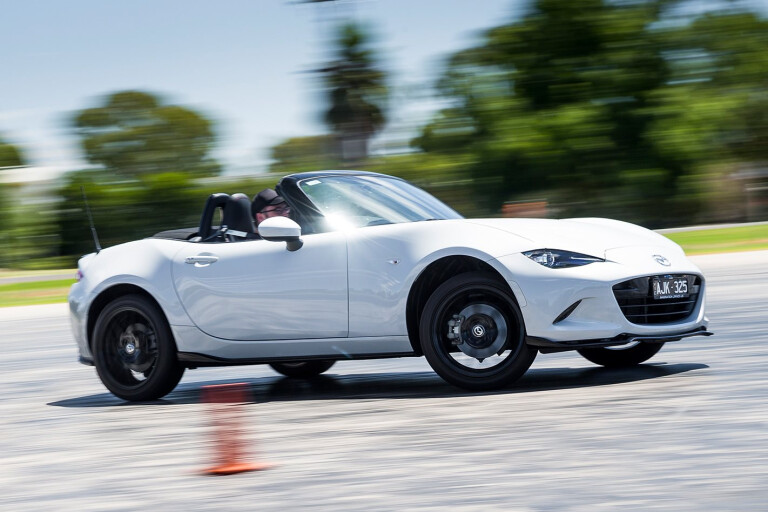
Despite what this magazine’s amazing photography might tell you, not every journalist can drift the tyres off a Ferrari. I know because I’m one of the sods who can’t handbrake turn to save his life.
Before joining chez MOTOR, my days at the track were spent keeping the car straight as possible, wary of any behaviour that saw otherwise. In fact, they still are.
The reason behind this is my first ‘performance’ car was a bum-dragger. Now, even though it was fine as front-drivers come, not even an early generation Honda Integra Type R, with its willingness to rotate under brakes, could teach you the dark art of controlled, willing drifts. That can only really be achieved with one thing, a propshaft.
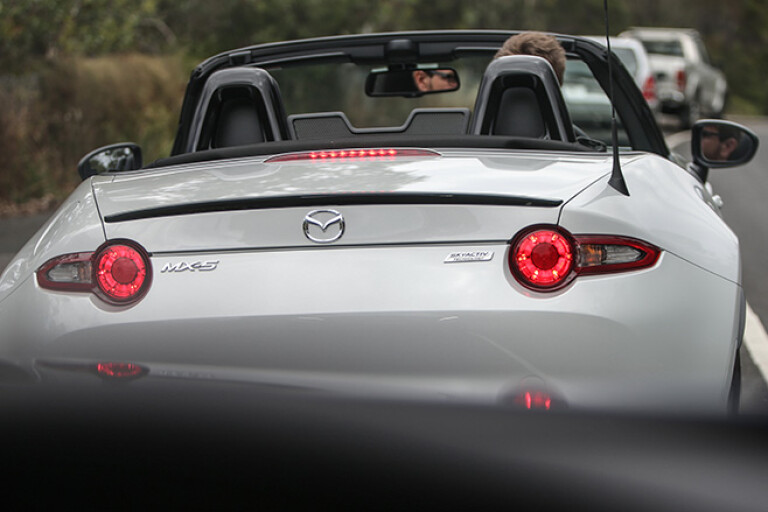
This is something the MX-5 has. But it doesn’t instantly make it, or you, a hero. I learnt this when tagging along to compare the MX-5, Abarth 124 Spider, and Subaru BRZ at DECA, in Shepparton. With its skidpan ours for half a day I seized the chance to have a few bites of sideways action.
With editor Dylan Campbell playing tutor, the instructions were to build speed, turn in, lift or brake to shift weight forward, feel the front load up, then floor the throttle to initiate the slide. Easy enough. The MX-5 didn’t need much provocation.
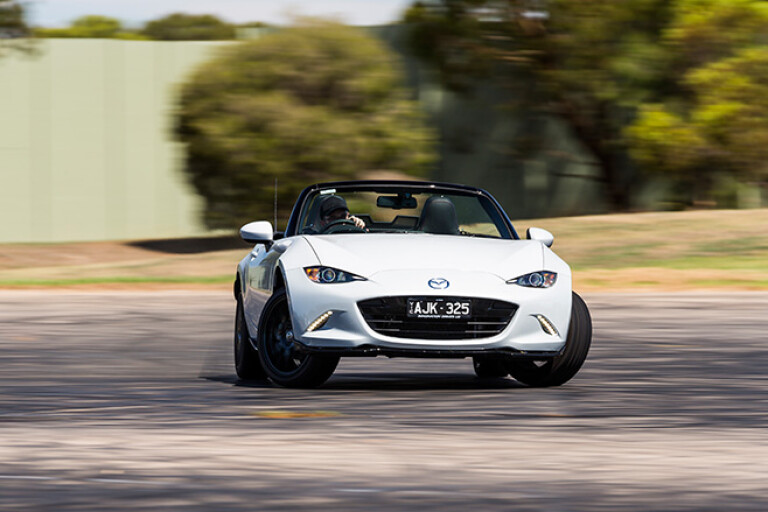
After initiating the slide it’s about balancing the throttle, power and steering to hold the slide. Which I found a little harder.
The front-end didn’t seem to have as much bite as I thought it would. And while it makes up for it with superb chassis balance, I found it hard to keep up with how quick everything happens and would heap on too much opposite lock, or throttle, to keep things straight. Transitions? Forget it.
The MX-5’s no Australian Drifting Grand Prix regular, for a few reasons. Its wheelbase measures just 2310mm. About 260mm shorter than an 86’s wheelbase, and a whopping 600mm less than a Commodore’s.
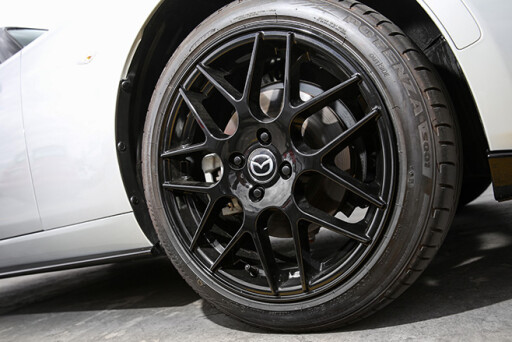 Then there’s its power. It’s a decent but not stonking 118kW and 200Nm, both delivered quite high in the rev range. Add to the list its significant bodyroll and relatively slow steering and you have a recipe for difficulty.
Then there’s its power. It’s a decent but not stonking 118kW and 200Nm, both delivered quite high in the rev range. Add to the list its significant bodyroll and relatively slow steering and you have a recipe for difficulty.
If you think I’m making excuses you’d be right – sorta. Because I can’t help feeling like a V8 Commodore would have made my day very different. A longer wheelbase would create a wider window in which to add opposite lock, and a LS3 would make more use of the right pedal’s travel. In the hope of maintaining a slide, I usually overdid the throttle and sent the MX-5 into a spin.
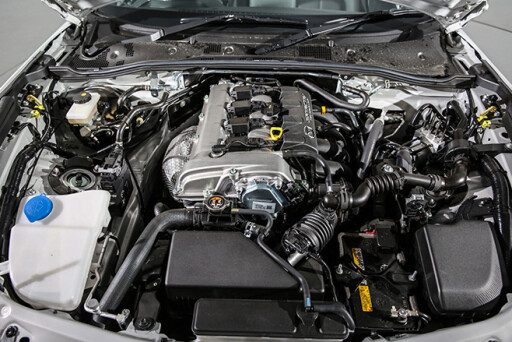 In spite of these frustrations, the MX-5 still stacks up as a brilliant device for slides, if only for the fact it needs to be mastered.
In spite of these frustrations, the MX-5 still stacks up as a brilliant device for slides, if only for the fact it needs to be mastered.
That’s probably why Japan’s discontinued but outrageously popular show, Best Motoring International, used the Roadster (as it’s known there) as a stepping stone for transforming a Super GT driver into a drift king.
Because in contrast to principles of ‘grip’ driving, being able to drift a low-powered car like the MX-5 indicates a developed level of skill. You’re forced to use momentum, timing, and judgement to greater effect. Which left me with the final thought that if you can drift the MX-5, you can probably can drift anything.

MONTH THREE
Fuel consumption: 7.68L/100km
Average fuel consumption: 8.6L/100km
Mileage this month: 642km
Total mileage: 4826km
Liked: Hanging out the MX-5’s little bum
Disliked: Spinning it. Many times
Favourite moment: Almost linking a transition
Update 3: Hard Choices
Mazda’s fitted the MX-5 with a hard hat, how does it compare?
.jpg )
At first glance, the differences between these two might seem only skin deep.
The MX-5 Retractable Fastback (a fancy term for its metal top) and our resident soft-top measure identical in everything besides height, which is up 5mm on the RF, while underneath, the RF’s stolen the 2.0-litre soft-top’s wheels, brakes, and tyres. They’re twins on paper.
So you’ll need to peer at them from other angles to spot the differences. Like from the side. Tucked behind the RF’s seats are flying buttresses which extend the roofline halfway down the MX-5’s boot.
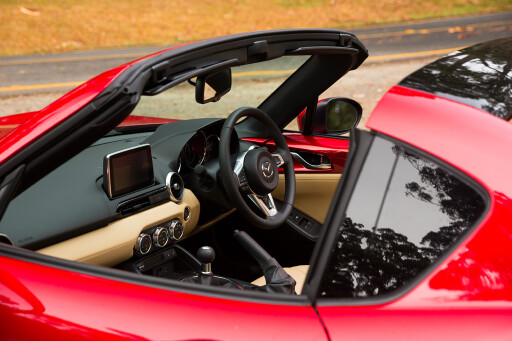 This shortens the RF’s butt, making its cabin appear more rearward, and visually stretches the bonnet, like some sort of baby Z4 M coupe. Squint at it from behind and you can even see a bit of F-Type Coupe.
This shortens the RF’s butt, making its cabin appear more rearward, and visually stretches the bonnet, like some sort of baby Z4 M coupe. Squint at it from behind and you can even see a bit of F-Type Coupe.
But there’s a niggling question about the RF: why’d Mazda build it? Sure, it’s pretty. But the soft-top’s no duffer. Nor have they slipped it more power to hunt down 86s or BRZs.
This aside, Mazda claims the RF is here to attract a ‘new kind of buyer’ with a ‘more premium experience’.
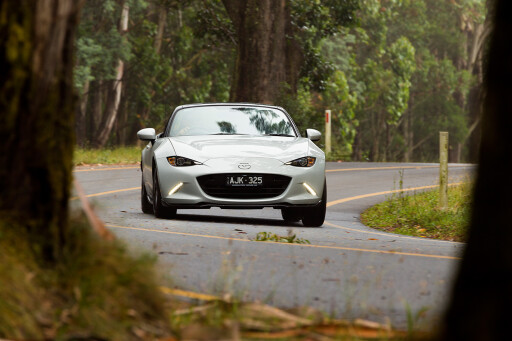 There’s no doubt the RF feels higher-grade than our own MX-5 from the moment you settle in it. Thumb the start button and a new colour LCD lights up in the dash, while the 2.0-litre inline four buzzes away under thicker layers of insulation.
There’s no doubt the RF feels higher-grade than our own MX-5 from the moment you settle in it. Thumb the start button and a new colour LCD lights up in the dash, while the 2.0-litre inline four buzzes away under thicker layers of insulation.
Dropping the roof, too, is no longer a chore – just a delay. Okay, 14 seconds isn’t long (except for millennials), but the RF will refuse to do it over 10km/h. So you can end up praying for stop-start traffic before the smoggy freeway tunnel you’re about to drive through for 10 minutes.
It’s a delight to watch, though, as it goes about folding away the three-piece roof like origami. The buttresses catch a lot of wind with the roof down, but cabin noise is markedly improved when up. And luggage space is only three litres poorer at 127L in the boot.
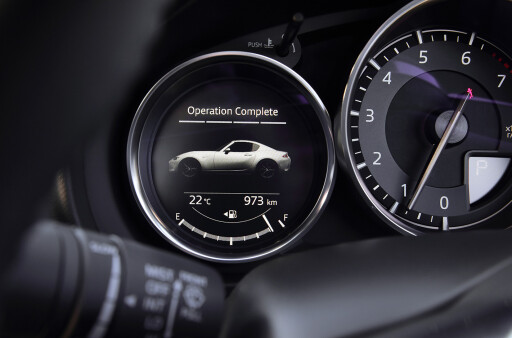 The real question is, however, whether the hardtop steers like our long termer. Mazda worked hard to slash 91kg from the last MX-5 generation, but the RF’s electric roof system stuffs 47kg back in.
The real question is, however, whether the hardtop steers like our long termer. Mazda worked hard to slash 91kg from the last MX-5 generation, but the RF’s electric roof system stuffs 47kg back in.
To combat the extra podge, Mazda drilled some holes in the RF’s tunnel member and regassed the suspension dampers to suit. The steering and bushes were also tweaked.
Hurrying both cars up and down some bends, then swapping for back-to-back impressions, an immediate difference between the soft- and hard-top emerges.
Cruising along at lower speeds, there’s a touch more float over bumps in the RF and the steering feels slower, and a touch heavier, at turnaround points.
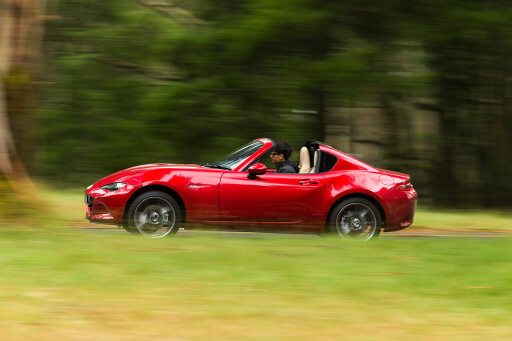 Body roll’s more progressive, which gives you more confidence to throw it into bends, but a more pedantic ESC cuts the fun sooner, preventing you from getting stuck into its chassis.
Body roll’s more progressive, which gives you more confidence to throw it into bends, but a more pedantic ESC cuts the fun sooner, preventing you from getting stuck into its chassis.
Back in the showroom, Mazda reckons the RF will make up 60 per cent of overall MX-5 sales. Ambitious when you consider its four variants are outnumbered by eight soft-tops, and the cheapest, a 2.0-litre RF manual, starts at $38,550 – or $6560 more than the cheapest 1.5-litre MX-5.
We’re not sure it’ll be quite that popular – Mazda’s already moved 2500 soft tops since launch – but we know that whoever buys one won’t be disappointed. Its extra class, practicality, and looks make it a perfect retirement present, especially if Sunday club runs will be its main use. However, if it were us, and the calendar had a few track days on it, we’d pick the softie.
MONTH FOUR
Fuel consumption: 8.57L/100km
Average fuel consumption: 8.59L/100km
Mileage this month: 876km
Total mileage: 5702km
Liked: Crusing in the RF’s added class
Disliked: The RF’s touchy ESP; its wind noise
Favourite moment: Taking in the RF’s sexy shape
Update 4: Family Ties
Meeting the Mazda MX-5's turbocharged Italian cousin: Fiat Abarth's 124 Spider
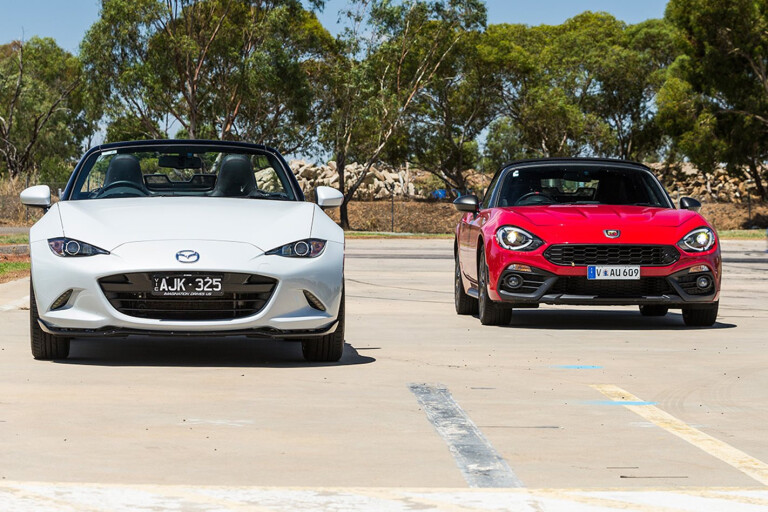
Grunt, how do you find more of the stuff?
That’s a question that surely keeps (some) Mazda MX-5 owners up at night. And one generated by my involvement in a recent comparison that included our MX-5 and Fiat Abarth’s 124 Spider.
Mazda’s given us a leg-up by lending us the 2.0-litre version of the MX-5. Its 118kW and 200Nm isn’t insignificant. It’s perfect around town, helping the MX-5 fill vacant traffic gaps and tear away from lumbering SUV blindspots. Meanwhile, the linear torque curve permits second- and even third-gear getaways if you’re a mechanical sadist.
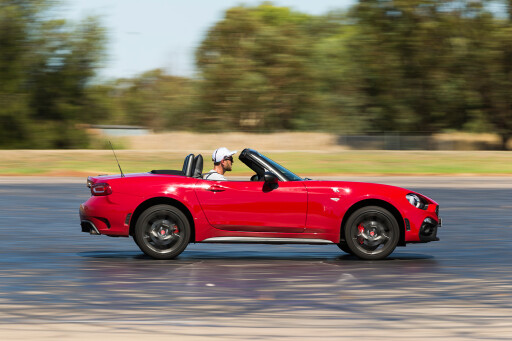 Beyond such civilian traits the engine delivers a thrilling and eager spin to its 6800rpm rev limit. Feeling potent enough to dispatch front-drive hot hatches and keep yesteryear’s V8 heroes very honest indeed.
Beyond such civilian traits the engine delivers a thrilling and eager spin to its 6800rpm rev limit. Feeling potent enough to dispatch front-drive hot hatches and keep yesteryear’s V8 heroes very honest indeed.
But where do you go when the acceleration fades into familiar territory? I haven’t tired of it five months in – 118kW feels reliably energetic in a car weighing 1033kg – but it’s a question that for many owners, eventually will be asked.
Open your mind so much that your brains fall out and American mob Flyin’ Miata is quite happy to sell you a kit that lets you bolt an LS3 V8 into your MX-5. You’ll cop a 172kg penalty and mess with the weight distribution, but you can imagine what 391kW does to the performance... And while the kit includes effectively a replacement powertrain (not just engine but T56 six-speed manual, custom driveshaft and Camaro rear diff) it’s not cheap – US$50K (AU$65K). And it’s BYO MX-5.
 Power-hungry readers not in a lunatic asylum might be tempted by a turbo kit from local mob Tunehouse. The Sydney-based engineering firm claims to have seen 138rwkW from its $7999 set-up. That’s about 185kW from the engine using a not-very-scientific conversion formula.
Power-hungry readers not in a lunatic asylum might be tempted by a turbo kit from local mob Tunehouse. The Sydney-based engineering firm claims to have seen 138rwkW from its $7999 set-up. That’s about 185kW from the engine using a not-very-scientific conversion formula.
This brings me back to the Abarth 124 Spider. If you’re really into the MX-5’s roadster chassis but want to fiddle with its engine, this might be the ticket. Out of the box it’s already packing an extra 7kW and 50Nm.

There’s also a decent amount of lag up until 3500rpm and you constantly run into the heavily undersquare 1.4-litre’s rev ceiling. But Tunehouse says a simple flash on the 124 will unlock another 20kW. And we see that high-mount turbocharger being awfully easy to replace. All the while being much easier to explain to the authorities. You get a mean noise thrown in, too. Which is nice.
You could try your best on the Mazda’s stock atmo 2.0-litre, but its finely-tuned state requires more for less. To liberate 20kW from the 124 with a tune you’ll need a new exhaust, too, Tunehouse says.
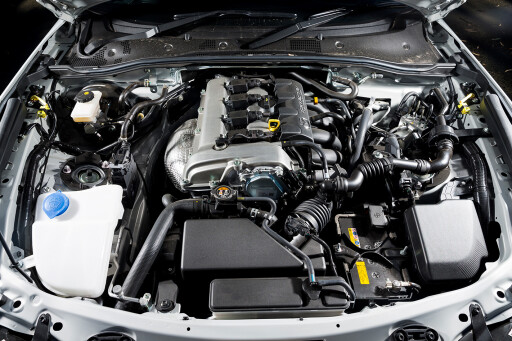 While many, if not most 2.0 MX-5 owners will be perfectly happy with their car’s sprightly 118kW, for readers who enjoy traction issues and for that reason had avoided the MX-5, Abarth may have opened the door to them by way of the 124 Spider’s ease of tuning. That is, until Mazda Australia has a crack at a new-age SP, of course. Which they should, as the MX-5 chassis we reckon could take it. And what a thing it would be.
While many, if not most 2.0 MX-5 owners will be perfectly happy with their car’s sprightly 118kW, for readers who enjoy traction issues and for that reason had avoided the MX-5, Abarth may have opened the door to them by way of the 124 Spider’s ease of tuning. That is, until Mazda Australia has a crack at a new-age SP, of course. Which they should, as the MX-5 chassis we reckon could take it. And what a thing it would be.
MONTH FIVE
Fuel consumption: 8.46L/100km
Average fuel consumption: 8.57L/100km
Mileage this month: 131km
Total mileage: 5832km
Liked: The MX-5’s off-the-line pace
Disliked: The 124 has a more evocative exhaust note
Favourite moment: Showing up its turbo cousin on the strip
Update 5: Conclusion
After a fun six months it’s time to bid goodbye to our MX-5

It was a dramatic change, for me, going from a Chrysler 300 SRT to Mazda’s MX-5. When the Japanese roadster replaced our American mobster six months ago, it was like going down three jean sizes.
Our butts already filled the Chrysler’s huge pews and our driving style had grown lazy with a big fat V8 under foot, which could crawl up a hill without even an ankle flex.
Then Mazda’s 2.0-litre GT, bearing the plates AJK325, rolled into our garage as my new steed. And we suddenly went from 462 litres of boot storage to a miniscule 130. We didn’t even have anywhere to store our phone. Where was our heated steering wheel, radar cruise, or thumping stereo? Like I said when I introduced the roadster, it was like swapping a burger with the lot for sashimi. And it left me a little hungry.

Thankfully, though, summer was coming into full swing. The perfect season for something fresh, light, and exotic. And I quickly discovered you could bring warm temperatures inside with a slam of the roof.
Yes, that manually operated roof was somewhat of a downgrade from the previous generation MX-5’s electrically operated one. But that mattered little when compared to the new car that came with it. Mazda was focused on aligning this generation as close to the original as possible by making it lightweight and fun.
Mr MX-5
After what I completed with the long-termer in the name of, ahem, research – sliding it across a skidpan, blasting up and down Mount Macedon with its hard-top sibling and chasing its segment rivals across rural Victoria – it’s obvious the company nailed its brief.

Mind you, it’s no oversteer hero and wouldn’t trouble a Megane RS on the road, but some of us don’t mind enjoying a mountain pass at our own pace. It’s a joy feeding it into corners with that fluid, electric steering rack, feeling its long-travel dampers roll onto its outside tyres, then sinking the throttle as its LSD-equipped rear end easily handles its modest outputs.
Drivers into slip, rather than grip, will find their fix much easier on the 1.5-litre’s softer suspension and smaller tyres, but I found the 2.0-litre’s stiffer package much more trusting. And that didn’t only come down to its suspension.
That 2.0-litre’s beefier torque made for rapid escapes from traffic lights and combined with the car’s retro-weight figure it’s the fastest MX-5 we’ve ever tested. Seriously, the previous generation hardtop, with 118kW and 188Nm, was good for 100km/h in 8.0sec and the quarter mile in 15.7sec. Meanwhile, our long termer thumps it with figures like 6.56sec and 14.68sec respectively.
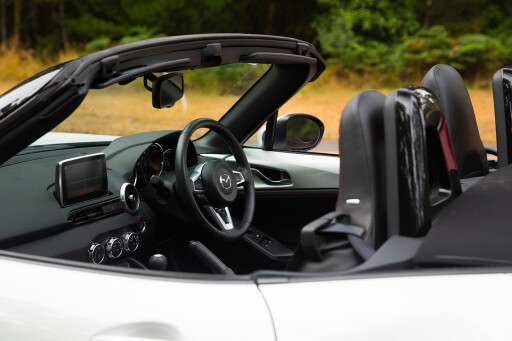
My relationship with the MX-5 also endured a couple of knocks, literally. An unknown assailant backed into it once, and at another point its Kuroi lip came loose. Despite this, it left our garage looking gorgeous as ever.
Sure, the whole hairdresser joke will follow the MX-5 to its grave, but the aftermarket’s never had an easier job fixing that. With that aggressive face, swooping silhouette, and raised rear haunches, the MX-5 has grown into an athletic-looking mite.
And the reason Mazda’s sold a million of them is because they appeal to your heart and head. Yes it’s a proper sportscar, hence it comes with appropriate downsides – a lack of storage, difficult ingress and compromised comfort (the MX-5 soft-top is rather noisy). But for less than $40K you can buy another car that’s none of those things. Or just sell your kids. Whatever it takes to get one in your garage. I know I would.

MONTH SIX
Fuel consumption: 8.25L/100km
Average fuel consumption: 7.87L/100km
Mileage this month: 403km
Total mileage: 6226km
Liked: Sunny days; twisty roads
Disliked: Transporting more than a parcel
Favourite moment: Shooting down the Great Ocean Road

COMMENTS